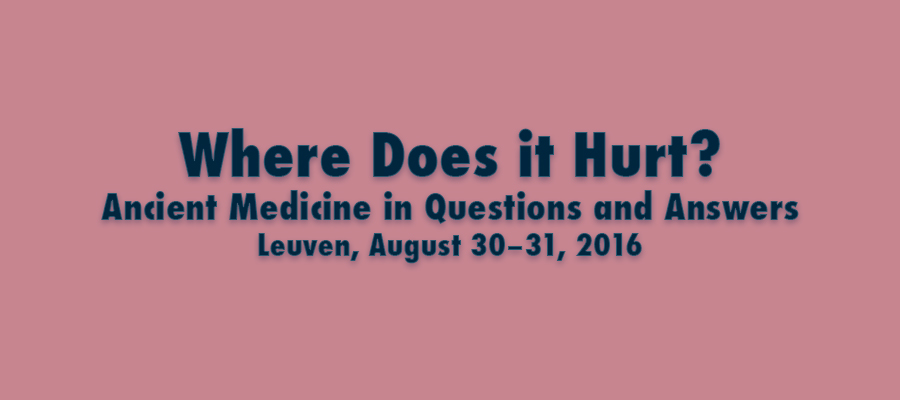Where Does it Hurt? Ancient Medicine in Questions and Answers, Leuven, August 30–31, 2016
Asking the right questions and obtaining the right answers is vital to modern medical healthcare. It is essential for efficient doctor-patient communication, forming an important component of medical treatment. This was no different in Antiquity. Already the Hippocratic writings give us an idea of which kinds of questions physicians asked in diagnosing their patients, and which answers they received in return (see, e.g., the case histories in the Epidemics). However, one can imagine that patients or, in case of severe illness, their relatives were often incapable of providing an accurate answer to (some of) the doctor’s questions. Galen, for instance, says that certain types of pain are actually felt by patients, but cannot be described by them when asked to (Loc. Aff. 2, 9 [8, 117 Kühn]). As such, a good doctor had to be able not simply to ask the right questions, but also to look for the right answers himself, if necessary.
The use of question-and-answer (Q&A) formulas is widely attested in ancient medical literature. By employing specific interrogative turns in their discourses, medical authors not only sought to provide practical information for proper treatment of patients, but also to amass theoretical insights about the human body and its physiological and pathological processes more generally. They dealt with several types of questions, including questions that sought to locate, define and explain certain illnesses or disorders in the body (“Where does it hurt?”, “What is it that hurts?”, ”Why does it hurt?”). Questions of this kind were common in medical treatises of the Greco-Roman period (they can be found, e.g., in medical manuals, medical papyri and collections of problemata). The popularity of the Q&A format is largely due to the fact that it became well-entrenched in the ancient medical school curriculum. Through its dialogical and interrogative structure, it provided teachers and students with a useful method to question and memorize all types of medical knowledge, both practical and theoretical. Once condensed in a textual form, it was also useful in transferring this knowledge between author and reader.
This conference aims to bring together scholars from the field of medical history and related fields (history of science, [natural] philosophy, theology, literary studies, linguistics, ...) with the goal of examining the role of Q&A in medical literature, from the Hippocratic writers to Late Antiquity and its reception in the Middle Ages. The conference is open to various approaches, and aims to address – but is not restricted to – questions of content (e.g., transfer and transformation of medical knowledge in Q&A style), textuality (e.g., development from orality to written text), context (e.g., socio-intellectual relations between doctor/patient, teacher/student, author/reader), and use (e.g., theoretical contemplation vs. practical application of medical knowledge).
